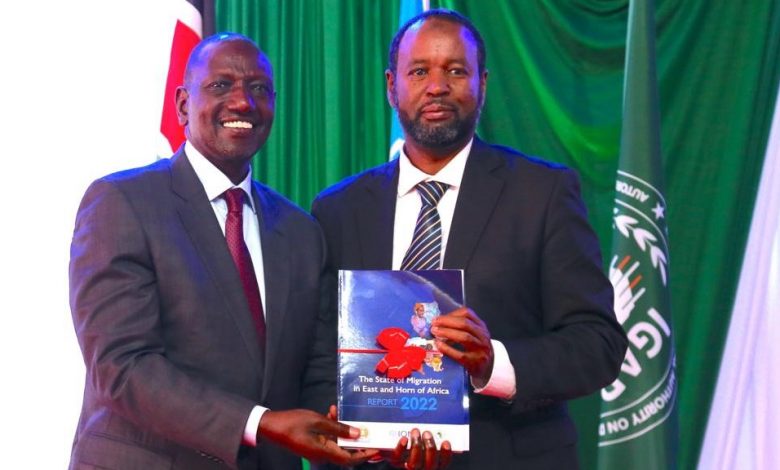Ruto calls for removal of barrier for movement of people to boost regional integration
President Ruto was speaking during the launch of a flagship report titled ‘The State of Migration in the East and Horn of Africa’’ at the Kenyatta International Convention Centre in Nairobi, Kenya.

Kenya’s President, William Samoei Ruto, has called on the East African Community (EAC) and the Intergovernmental Authority on Development (IGAD) member states to remove barriers on the movement of people, services and goods in order to enhance regional integration that is necessary for sustainable growth and development of the East and Horn of African region.
The President said it is the responsibility of the member states in the region to remove the barriers of boundaries that has since become roadblocks and an impediment to the movement of people, goods and services. The President criticized political boundaries as old-fashioned and divisive and urged the region to work together to build bridges of friendship.
“We must not give credibility to the artificial boundaries that exist in our region and a product of a Conference held in Berlin, Germany that partitioned our Continent and allocated us boundaries. We must bring down these barriers, convert them to stepping stones and build bridges of friendship’’, said President Ruto.
President Ruto was speaking during the launch of a flagship report titled ‘The State of Migration in the East and Horn of Africa’’ at the Kenyatta International Convention Centre in Nairobi, Kenya.
The President praised the report as a valuable contribution that fills a knowledge gap in the domain of regional integration, particularly in the area of human mobility.
“I appreciate all the wonderful contributions of EAC, IGAD and IOM, the authors, as well as the entire editorial team for the work that has made the ‘State of Migration in East and Horn of Africa Report’ such an authoritative and informative publication,’’ he added.
President Ruto invited relevant policymakers in the region to use the report’s analysis and recommendations to inform their policymaking and implementation efforts to advance the critical element of human mobility, as well as its broader context of regional integration.
On his part, the EAC Secretary General, Peter Mathuki, said the Report provides policy suggestions to address challenges in advancing the mobility dimensions of regional integration, including labour migration, and continued collaboration between Regional Economic Communities (RECs) on areas of common interest.
“I am optimistic that practitioners and policymakers will find this Report a valuable basis for migration-related policy development in an integrated region,’ Mathuki said.
Mathuki said the EAC is working on an improved legal and regulatory environment to provide for labour mobility by creating the necessary infrastructure in the refugees hosting areas to attract private sector investment climate and empower them economically in collaboration with UNHCR, IGAD and the African Development Bank (AfDB).
He noted that the EAC region is hosting about 3.3 million migrants in form of refugees, of which Uganda hosts the highest number with 1.6 million refugees; 469,414 refugees in Kenya; 467,744 in DRC; 308,374 in South Sudan; 191,042 in Tanzania; 128,064 in Rwanda and 110,000 in Burundi.
Mathuki noted that despite the challenges, migration has also brought about significant positive contributions to the region, including the transfer of skills and knowledge, remittances, and the creation of diverse and vibrant communities.
The Secretary General pledged the EAC’s commitment to continue working with all Partners in supporting Partner States to implement the recommendations from the Report.
The Regional Director, IOM Regional Office for East and Horn of Africa, Mohammed Abdiker, noted that in its 12 chapters, the report examines the mobility aspects of migration along three umbrella themes; free movement of goods and services and the free movement of persons as essential to harnessing the benefits of intra-African trade; labour mobility and economic integration, safer human mobility as well as integrated border governance, especially through One-Stop Border Posts (OSBPs).
He revealed that the report provides contemporary thinking on the mobility dimension of regional integration and serves as an intellectual compass for defining the future policy agenda of the Regional Economic Communities and governments.
On his part, IGAD Executive Secretary, Dr Workneh Gebeyehu, said the level of analysis and evidence provided by the report is a true reflection of the state of migration in the region.
“IGAD stands ready to implement the recommendations and suggestions forwarded by the report jointly with Member States and partners,” he reaffirmed.
The report is the first comprehensive analysis of the mobility dimensions of regional integration, covering migration and mobility trends, trade and mobility, labour mobility, cross-border health, climate change and human mobility, sustainable reintegration, gender, integrated border management, digitalization, and the Global Compact for Migration.
The analysis covers 12 countries in the East and Horn of Africa region: Burundi, Djibouti, the Democratic Republic of Congo, Ethiopia, Eritrea, Kenya, Rwanda, Somalia, South Sudan, Sudan, United Republic of Tanzania and Uganda.
The report highlights that access to health remains an essential part of ensuring cross-border movement is safe, and that climate change plays a major role in reshaping the mobility of persons. The report also highlights gender equity as a cross-cutting and critically important face of human mobility and regional integration.







